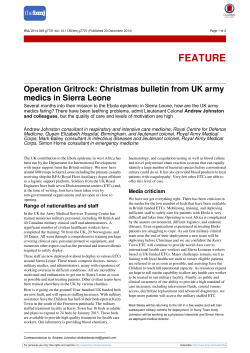
VIEWS & REVIEWS - BMJ Press Releases
BMJ 2015;350:h1734 doi: 10.1136/bmj.h1734 Page 1 of 2 Views & Reviews VIEWS & REVIEWS PERSONAL VIEW Bureaucracy and budget revision: how spending cuts are affecting India’s public health programmes Healthcare in India needs more funding, not less, says Leena Menghaney, reflecting on services for people with HIV after cuts to some health budgets of as much as 20% Leena Menghaney lawyer working on public health law and policy, New Delhi, India I have seen huge insufficiencies in India’s HIV programme recently, perhaps unprecedented since I started working as an AIDS treatment activist in 2002. It is sobering to witness people, particularly children, getting sick because the drugs and diagnostics that are mostly taken for granted in the developed world are not available. Two factors are slowing India’s progress on health indicators and access to drugs. Firstly, the government’s health spending has stagnated at just over 1% of gross domestic product (GDP), when the World Health Organization recommends 5%; secondly, the Ministry of Health and its programmes are unable to use much of the funding that has been allocated. Revision and reduction of allocated spending For example, the National AIDS Control Organisation (NACO) was allocated a domestic budget of Rs2861 crore (£309m; €420m; $460m)1 from 2007 to 2017, but only Rs1115 crore was spent.2 Each financial year, when NACO fails to spend a substantial part of its annual domestic budget, the Ministry of Finance revises and reduces its spending. Endless bureaucratic delays in implementing prevention and treatment services for many of the Ministry of Health’s national programmes leaves millions unspent—hence the routine but deadly mid-year budget revisions. In 2014 the AIDS programme was again presented with a mid-year revision of its budget, and the allocation for drugs, kits, and consumables was reduced from over Rs450 crore to Rs157 crore.3 Unused funds were also transferred to new projects such as Swachh Bharat Abhiyan (Clean India Mission) in the last quarter of 2014, while frontline AIDS workers were not paid, essential monitoring tools for HIV treatment such as viral load kits were not purchased, and approvals of bids to procure critical prevention tools were delayed, such as condoms and kits for HIV testing and diagnosing sexually transmitted infections (STIs). Co-infections such as hepatitis C add to increased morbidity and mortality among people with HIV. But publicly funded treatment for co-infections in addition to antiretroviral drugs is seen as impossible despite the availability of unspent funds. Months without pay for healthcare workers This is not all. Healthcare workers employed by the National Health Mission to provide basic medical services were not paid for months. Funds for the national AIDS and STI control programme and the National Health Mission were, for the first time, sent directly to state treasuries rather than to the states’ AIDS control societies and health units.4 The policy was well intentioned, designed to give states a greater role and more financial power, but the central government failed to plan and coordinate the change sufficiently. Tens of millions of rupees are yet to be released by state finance departments, while public health goes without. Because funds remained unspent, it came as no surprise that the Ministry of Finance in December 2014 revised and ultimately announced a 15% budget cut in the health ministry’s 2014-15 expenditure. Concurrently, more than 40 million people in India face financial hardship, debt, and impoverishment because of out-of-pocket health expenditure (largely for drugs), while the government continues to slash the health ministry’s budget each year. And, for the next financial year (2015-16), the national AIDS programme’s budget has been slashed by almost Rs300 crore from the previous year, including funding for the supply of essential prevention tools such as condoms. The allocated Rs1397 crore is considered barely enough for maintaining prevention and treatment interventions at their current levels.5 The health budget for 2015-16 is only marginally higher than the previous year’s and is nowhere near the 2.5% of GDP that the new government’s draft National Health Policy proposes. leenamenghaney@gmail.com For personal use only: See rights and reprints http://www.bmj.com/permissions Subscribe: http://www.bmj.com/subscribe BMJ 2015;350:h1734 doi: 10.1136/bmj.h1734 Page 2 of 2 VIEWS & REVIEWS A disastrous go-slow policy We should be expanding interventions for public health, such as those for viral hepatitis and non-communicable diseases. As 50 million people with chronic hepatitis B and C struggle for access to reliable testing, diagnostics, and treatment in India’s expensive private healthcare sector, the government has allocated a mere Rs5 crore for the start of a surveillance programme by the National Institute of Communicable Diseases. Chronic lung disease beyond tuberculosis has not been prioritised, and early diagnosis of breast and cervical cancers that could save the lives of millions of women is not considered in programmes related to reproductive and sexual health. Similarly to previous governments, this new government is adopting a disastrous go-slow policy when it comes to increasing the health budget and using it effectively. In India, universal health coverage—strongly associated with poverty reduction, economic development, and a better public health system—remains a distant dream. For personal use only: See rights and reprints http://www.bmj.com/permissions Competing interests: I have read and understood the BMJ policy on declaration of interests and have no relevant interests to declare. Provenance and peer review: Commissioned; not externally peer reviewed. 1 2 3 4 5 Working Group on Financial Management, First consultation meeting 24-26 May 2011. http://bit.ly/1CPI4LJ. Department of AIDS Control, Ministry of Health & Family Welfare. Annual report 2013-14. www.naco.gov.in/upload/2014%20mslns/NACO_English%202013-14.pdf. Department of AIDS Control, Ministry of Health & Family Welfare (Demand no 50). Union budget 2015-16: notes on demands for grants, 2015-2016. http://indiabudget.nic.in/ub201516/eb/sbe50.pdf. Kalra A. Payment delays dent India’s flagship health, AIDS programmes. Reuters 3 March 2015. http://news.yahoo.com/exclusive-payment-delays-dent-indias-flagship-health-aids023049886--business.html. Prasada Rao JVR. Centre must rethink its public health policy. Hindustan Times 19 March 2015. www.hindustantimes.com/analysis/centre-must-rethink-its-public-health-policy/ article1-1327998.aspx. Cite this as: BMJ 2015;350:h1734 © BMJ Publishing Group Ltd 2015 Subscribe: http://www.bmj.com/subscribe
© Copyright 2025









